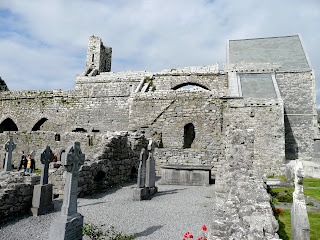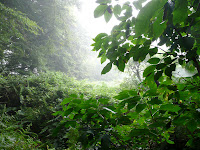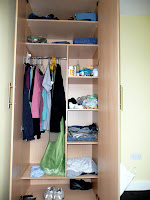Archaeology Field Trip #4: Overnight to the Burren and Sites around Co. Clare, September 16-17, 2008
Well, the best was certainly saved for last. I remembered loving the Burren (a karst, barren, limestone landscape in Co. Clare) but I didn’t expect my return to be quite so…triumphant!
We started at Kilfenora, the only cathedral in the Burren (it still is recognized as a cathedral, too…it’s technically directly under the authority of the Pope since it doesn’t have a bishop). We went to go see it’s 12th century high crosses but it’s also known as the shooting location of an episode of one of the world’s best television shows: “Father Ted.” The high crosses were beautiful and it was nice to get out and wander around a bit after our several-hour-long bus trip.


Next, we went to Leamaneh Castle. Leamaneh was originally a tower house (like Ballinacarriga…see trip #1) but was added to to make a fortified house (like Coppinger’s Court, also trip #1). We couldn’t get terribly close since the property owner keeps the field locked up (in an attempt to get money from the government to make the site more protected as well as accessible).

From Leamaneh Castle we drove to Poulnabrone, a portal tomb (again, a form from around 4000-3000BC). Poulnabrone is interesting for a couple of reasons: First, its image is used in nearly every tourism scheme imaginable (see my picture? Seen it before? Yeah.). Secondly, it is in the part of the Burren designated as a national park. Because the barren limestone landscape is primarily a result of erosion from overfarming, the national park part of the Burren has already begun to revert back to a tree-covered grassy green area with significant soil build-up over the last twenty years or so. So, the part of the Burren designated by the government to be protected so as to preserve this “unique landscape” is becoming like the rest of Ireland whereas the unprotected bits are distinctly Burren-like.

From Poulnabrone, we made our way to Corcomroe Cistercian Abbey (loads of clambering all over rock walls and exploring! I felt like a little kid again!) and then Cahercommaun (a cashel, or stone ringfort). We ended our day at the Cliffs of Moher before heading to Ennistymon to check in for the night and head out to the pub.



Expecting a hostel, we were stunned when we arrived at the Fall’s Hotel, Ennistymon…it was a real hotel! There were only two people in each room and we had soft beds with pillow-top mattresses! Our dinner was three courses! I woke up the next morning and my back did not hurt!
After a wonderful hot breakfast, we left for Quin Franciscan Friary. In remarkably good condition, Quin features a gorgeously preserved cloister and, again, much clambering about made the day even better.


From Quin, we went to Moughaun Hillfort. The thing about Moughaun is that it’s important because it is gigantic (the central ring is 100m in diameter). But since it’s so big and since it’s a hillfort (an earthen construction) there really is nothing to see. Instead, we climbed/walked to the center of it, imagined being in the center of a huge construction, and moved on.
We finished the day by going to Bunratty Castle and Folk Park. For those in the dark, Bunratty is a bit like the Colonial Williamsburg of Ireland. Or perhaps Disneyland. Every night they do “medieval banquets” for coach tours (we had to go to one during our orientation…oh god). The folk park is filled with reconstructed cottages, random farm animals, and re-enactors (re-enactors give me the heeby-jeebies. I hate it when people are “in character” at sites like this…that’s my main problem with Renn Fairs.) So lunch was great and instead of being creeped out by re-enactors or thinking about how strange and tourist trappy Bunratty is, I played on the playground and ran about looking at cute animals.
The trip to the Burren and County Clare was a great way to end our Early Start. The weather could not have been better and it was fun to be able to climb around and explore like a kid again.
 Transplanted Potato
Transplanted Potato




































